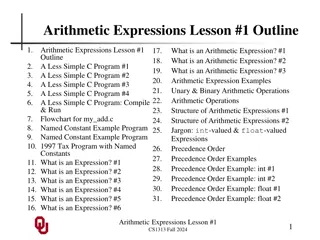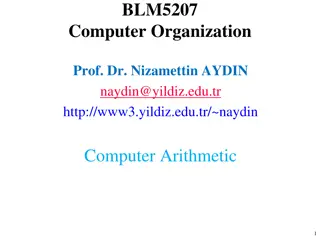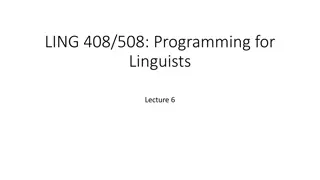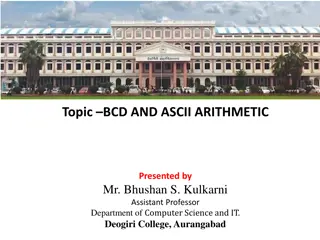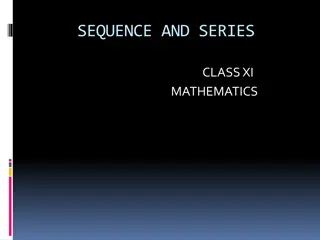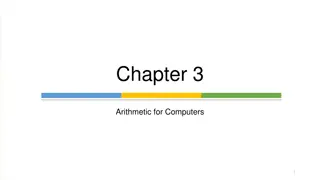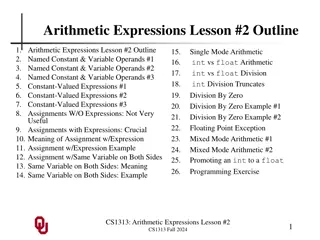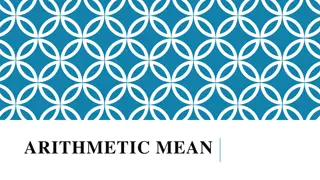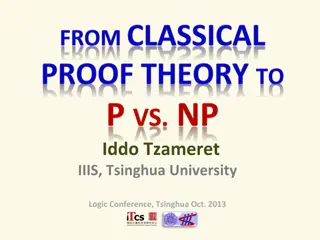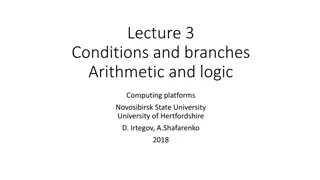Understanding Arithmetic Statistics in Function Fields
Delve into the world of arithmetic statistics in function fields, exploring concepts like the Divisor function, Dirichlet divisor problem, counting methods, Euler summation formula, and more. Discover the beauty of number theory through the lens of these mathematical functions and distributions.
Download Presentation

Please find below an Image/Link to download the presentation.
The content on the website is provided AS IS for your information and personal use only. It may not be sold, licensed, or shared on other websites without obtaining consent from the author. Download presentation by click this link. If you encounter any issues during the download, it is possible that the publisher has removed the file from their server.
E N D
Presentation Transcript
Arithmetic Statistics in Function Fields
The Divisor function The divisor function ? ? counts the number of divisors of an integer ?. ? ? = 1 = 1 ?,? ??=? ?|? Dirichlet divisor problem: Determine the asymptotic behaviour as ? of the sum ? ? = ?(?) ? ? ? ? = ? ??(?) = ? ? ?|?1 = ?,? ?? ?1 This is a count of lattice points under the hyperbola ?? = ?
Counting method Make use of the symmetry of the region about the line ? = ? count twice the number of lattice points under the hyperbola ?? = ? and under the line ? = ?. * On the diagonal line ? = ? there are ? lattice points. ? ? ? lattice points. * On horizontal lines we have
Therefore ? ? ?(?) = 2 ( ?) + ? ? ? ? ? Use ? = ? + ?(1) and the Euler summation formula 1 ?= log? + ? + ? 1 ? ? ? ? ? = ????? + 2? 1 ? + ?( ?)
Dirichlet s divisor problem: ? ? ?? ? ?log? + 2? 1 ? 1 2 Dirichlet: ? ? 1 3+? Voronoi (1903): ? ? 131 416+? Huxley (2003): ? ? Problem (Divisor function in short intervals): The limiting distribution of ?<? ?+?(?)?(?) when ? . The trivial range: For ? ? = ??and ? >131 416, as ? ?(?)~? ? log? ?<? ?+?(?)
The Divisor function in short intervals ?;? = ? + ? ? Define 1 2 ? Ivic (2009): For ??< ? <1 2? 2??~??3(log? 2log?) 2? ?;? 1 ? ? with ?3a certain cubic polynomial.
The generalized Divisor function The k-th divisor function ??? : ??? #{ ?1, ,??: ? = ?1 ??, ?1, ,?? 1} The classical divisor function ? ? = ?|?1 being ? ? = ?2? . Example: for a prime number ?, ????=#{ ?1, ,??: ? = ?1+ +??, ? + ? 1 ? 1 ?1, ,?? 0} ????= Generalization of Dirichlet s divisor problem: k? ? ???? ??? 1(log?), where ?? 1is a certain polynomial of degree ? 1.
The generalized Divisor function in short intervals ? 1< ? < 1 1 1 Lester (2015): ? = ??, 1 ?????? ??) ?then (assuming 2??~????? ? log??2 1 2? ??;? 1 ? ? Conjecture J.P.Keating, B.Rodgers, ER-G and Z.Rudnick (2015) ? = ??, ? < ? < 1 1 ?, then 1 ? ? Where ??? is a piecewise polynomial function in ?, of degree ?2 1 2??~????? ? log??2 1 2? ??;?
Function fields ??a finite field (? is a power of an odd prime) ??? the ring of polynomials with coefficients in ??. ?? ? ??? :deg? = ? the set of polynomials of degree ? ?? ? ??? :deg? = ?, ? ????? be the subset of monic polynomials. The norm of ? ??[?] is defined by ? := ???? ?. The k-th divisor function ??? ??? #{ ?1, ,??: ? = ?1 ??, Compare with number fields: ?? log? ?1, ,???????} ? ? ? ??
Divisors in function fields The analogue of Dirichlet divisor problem: ?(?) ??? ? ?? Over function fields- an easy computation: 1 ? ? = ? ??????deg ?= ?=0 ????= 1 ?? The k-th power of the zeta function is the generating function of ? ????? . 1 ?(?)?= ? ???????? ???? ?= ?=0 ? ????? ??= (1 ??)? Expand + compare the coefficient of ?? ? ????? = ?? ?+? 1 . ? 1
Short intervals in ??[?] For ? ??and < ?, an interval around ? of length is ? ?; ?: ? ? ? = ? + ? Note that H #? ?; = ? +1. The sum over short interval ????; := ? ? ?; ??(?) The mean value is 1 ?? ? ?? ??? ; = ????; Define ??; ????; ??? ; Our goal: to study the variance of ???(in the limit of a large field size) var ??? ; = 1 2 ?? ? ??| | ??;
Short intervals as arithmetic progressions There is a bijection between Intervals and arithmetic progressions: 1 ? ? ??? ??? ?? ? ?; When ? = ? +1? , deg ? = ? 1 This covers all intervals since ??= ? ?? 1?(? +1?; )
Variance in short intervals Theorem (J.P.Keating, B.Rodgers, E.R-G and Z.Rudnick 2015) Let n 5, and min( 1 1 1 ?? ? ?? ?? 1 ,? 5) , then as ? 2~? +1Ik(n;n h 2) ??; 2?? ?1+ +??=? 0 ?1, ,?? ? Where I??;? ? ? ???1? ????? ? ???? ?? and ???? are the secular coefficients: det ? + ?? = ?=0 Corollary: If n 8 and <? 2 1 , then as ? 1 ?? ? ?? 2~? +1(? 2 + 5)(? 2 + 6)(? 2 + 7) 2?; 6
Comparison between number field and function field results (short intervals) Number field Function field ?? ? log? + 1 ? +1 ? For ??< ? <1 If < ?/2 then 2?1/2 1 ?? ? ?? 2~ 2?; 2??~ 2? 2?; 1 ? ? ??3(log? 2log?) ? +1Poly3(n 2h)
Ingredients of the proof Orthogonality relation for Dirichlet characters mod Q: (?) ? ??? ? ? ? ? ? = 1 ? = ? ??? ? ?? ?????? 1 0 (?) ? ??? ? ?1? ?2? = 1 ?1= ?2 ?? ?????? 1 0 Even characters ? ?? = ?(?) for all ? ?? ? ?,? := ?,? =11 ? ? ?deg ? 1= ?=1 deg ? 1(1 ??? ?) 1 2 Riemann Hypothesis (proved by Weil) :|??? | = ? Spectral interpretation (for primitive even characters): 1 2 ?) , ?= ???? ???1, ,???deg ? 1 ? ?,? = (1 ?)det(? ??
The main ingredient Theorem (Nick Katz 2013) The unitarized Frobenii ?when ? is an even primitive character mod ??+1become equidistributed in PU(m-1) as ? . 1 ?? ?( ?)~ ? ? ?? ??? ? ??? ?? ? ?0 ??(? 2) ? ?? ???? ??? ?????????
Sketch of the proof ? ????? ? ? ?; ??(?) evaluated in terms of ? ? restrict to an interval using orthogonality relations for Dirichlet character evaluate in terms of the associated Dirichlet L- functions Write the L-functions in terms of unitary matrices 1 2 ? ? ?,? = 1 ? det ? ?? The variance ~ 2 1 ?? ???1 ? ???? ? ?1+ +??=n 0 ?1, ,?? n h 2 ? ??? ?? ? ?0 ??? ? ?? ???? ??? ?????????
Sketch of the proof Apply Katz equidistribution result 2 1 ?? ???1 ? ???? ? ??? ?1+ +??=n 0 ?1, ,?? n h 2 ? ??? ?? ? ?0 ? ?? ???? ??? ????????? 2?? ~ ? n h 2 ???1? ????? ?1+ +??=n 0 ?1, ,?? n h 2
Matrix Integral What do we know about I??;? ? ? 2?? ? ?1+ +??=? 0 ?1, ,?? ? ???1? ????? For ? > ?? ,I??;? = 0. ?+?2 1 ?2 1 I??;? = , ? < ? Functional equation I??;? = I??? ?;? . ?? ? + ?2 1 I??;? = , ? 1 ? < ? < ?? ?2 1
Theorem (J.P.Keating, B.Rodgers, ER-G and Z.Rudnick) I??;? is equal to the count of lattice points ? = (?? each of the relations ?) ( )?2satisfying ? ? for all 1 ?,? ?. 1.0 ?? ?+ ?2 ? 1+ + ?? 1= ?? ?. 2.?1 3.? ??, where ??is the collection of ? ? matrices whose entries satisfy the following system of equalities,
Theorem (J.P.Keating, B.Rodgers, E.RG and Z.Rudnick 2015) Let ? ?/?. Then for ? 0,? , I??;? = ??? ??2 1+ ?(??2 2) With 1 2dkw ??? = ?!? 1 + ?2 0,1????1+ + ?? ?? ?? ?<? Here ? is the Barnes G-function, so that for positive integers k, ? 1 + ? = 1! 2! 3! ? 1 ! ??? is a piecewise polynomial which changes when ever ? reaches an integer.







